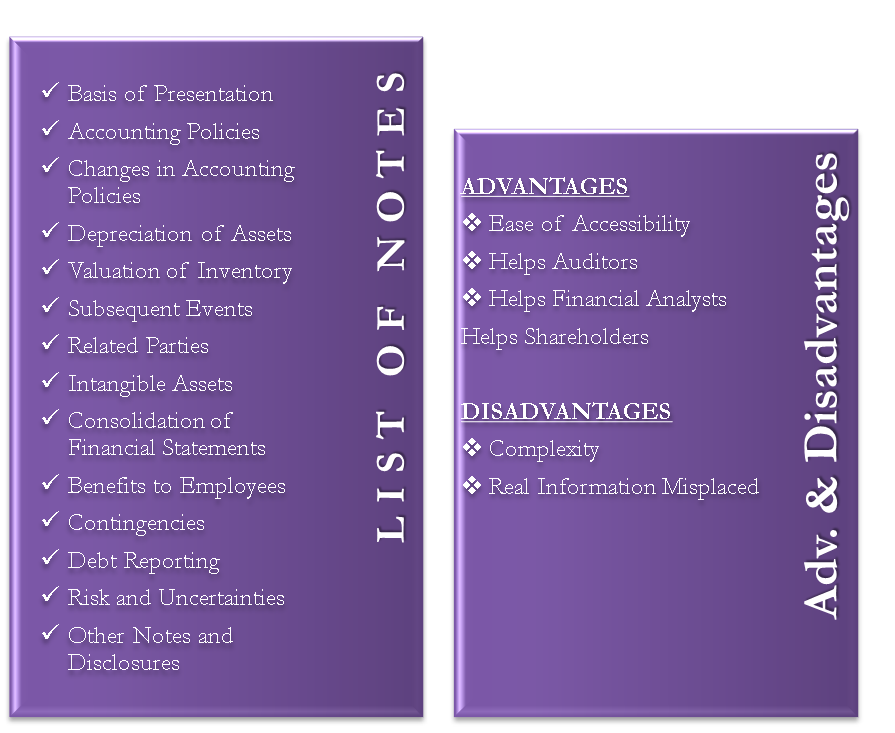Financial Statement Notes / Footnotes
Financial statement notes are the additional important information apart from the basic three financial statements. These notes to financial statements clarify the users in the correct interpretation of the financial statements. Does the presentation totally depend upon what standardized accounting principles (GAAP or IFRS) are followed? Yes, you are right, they will be different in each country. It depends on the disclosure requirements in the respective country’s standards or the law.
Importance / Benefits of Financial Statement Notes
If we look at financial statements, they are just numbers and numbers. A true understanding of the state of affairs is not possible until you understand how those numbers arrive. Let’s look at it from the opposite angle. If these notes were mixed with the financial statements, wouldn’t it create clutter in the annual report? To avoid such clutter, notes to financial statements are separated from financial statements. Also, it facilitates ease to a different levels of users. For example, a user who is just interested in how much dividend is declared can only go to the required section and find out. If the user is an analyst, he will not only read the financial statements but will do an in-depth analysis of the footnotes also.
Overall, with financial statement notes, the annual report of a company is organized for efficient and appropriate use.
Ease of Accessibility
Easy access saves the time of a user. Users have the most important things highlighted in the financial statements. They may or may not refer or may selectively refer to notes as per his requirements.
Helps Auditors
Financial auditors are required to furnish their opinion on the financial statements. These notes help auditors in forming their opinion about the financial statements.
Helps Financial Analysts
A financial analyst refers to financial statements for analysis and information on future events to help the analysts project the valuation of a company in the coming future.
Also Read: Types of Financial Statements
Helps Shareholders
These notes help shareholders understand the real performance of the company last year as well as project the growth in the coming years.

Disadvantages
Complexity
The notes and disclosure requirements are so complex in big-sized companies that a non-specialist cannot understand them till they have a fair knowledge of accounting practices.
Real Information Misplaced
In pursuit of better clarity, a lot of important information is hidden. The quantum of notes is too heavy. So, finding the important information out of these becomes a herculean task and requires expert knowledge.
List of Financial Statements Notes and Disclosures
Basis of Presentation
It explains the basis for preparing and presenting financial statements.
Accounting Policies
It specifies the accounting policies used while constructing the financial statements like depreciation method, inventory valuation method, etc.
Changes in Accounting Policies
Accounting policy seldom changes. If, for the sake of better presentation, changes in accounting policies are required, it is specifically mentioned in the notes.
Depreciation of Assets
This note mentions the method adopted for depreciating the assets. Any change compared to the previous year is highlighted.
Valuation of Inventory
This note mentions the policy adopted for inventory valuation in the books. Specific identification, weighted average, and FIFO are allowed in GAAP. Last in, first-out (LIFO) is not allowed. There are various methods for the management of inventory.
Subsequent Events
Type I and Type II events are specified in the required details. These are events that have occurred after the completion of the financial year. Type I events are those which can affect the financial statements, whereas Type II events do have any impact on the financial statements under audit.
Also Read: Presentation of Financial Statements
Related Parties
Transactions carried out with related parties, and the methods and policies used for pricing or valuing the transactions are mentioned.
Intangible Assets
A company needs to mention all intangible assets it owns. They also have to explain how the value of those intangible assets is determined.
Consolidation of Financial Statements
The basis for consolidating accounts with other subsidiary companies is mentioned here.
Benefits to Employees
This note mentions the benefits that a company offers to its employees during the job and post-retirement. These benefits may be medical, other fringe benefits, etc.
Contingencies
This note primarily deals with contingent liabilities—the liabilities which may or may not occur in the future. For example, a court case by a big customer for claiming the refund of his money on account of quality issues. If the court case is lost, the company may come under a big liability.
Debt Reporting
This note presents information on the debts of the company. The primary information about each loan, like interest rates, maturities over the next 5 years, etc., are given here.
Risk and Uncertainties
This note presents the various risks and uncertainties that a company or its business faces.
Other Notes and Disclosures
Above is not an exclusive list of notes; there can be notes on the following depending on the company and its business.
- Non-monetary transactions
- Management discussion and analysis
- Fair Value
- Cash
- Business Combinations
- Receivables
- Investments
- Goodwill
- Segment Data
- Revenue Recognition, etc.

